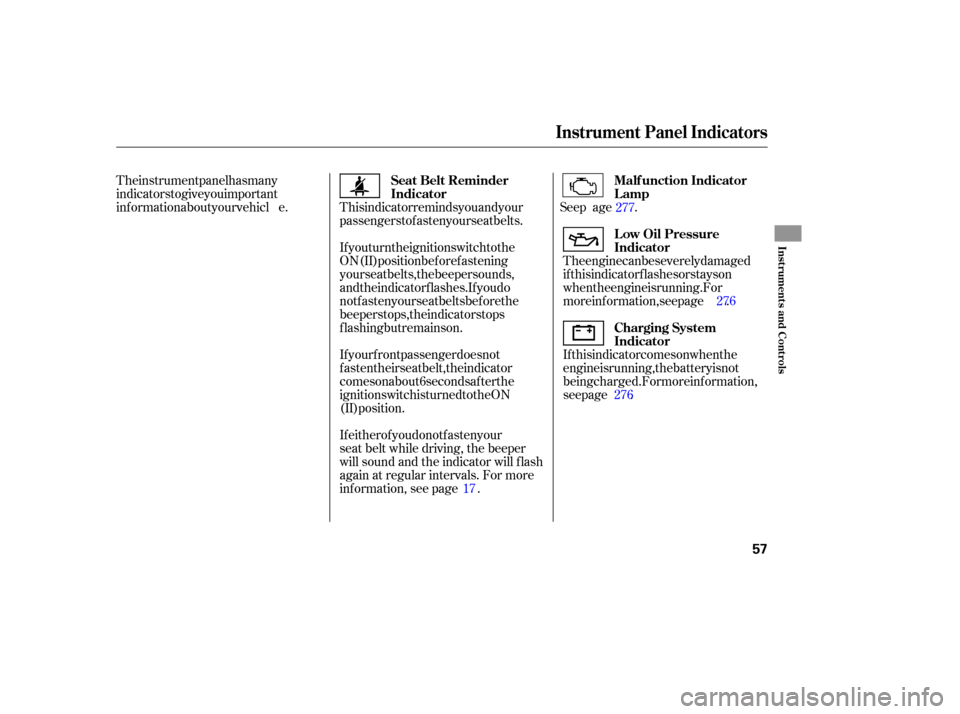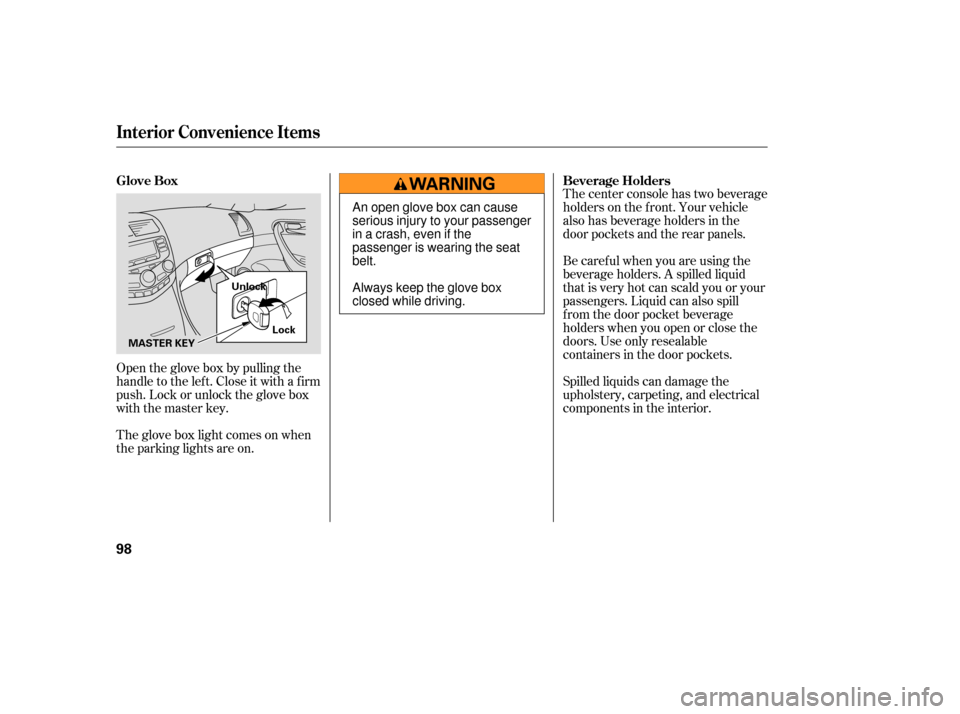Page 59 of 319

The instrument panel has many
indicators to give you important
info rmation about your vehicl e. See p age .
The engine can be severely damaged
if this indicator flashes or stays on
when the engine is running. For
more information, see page .
If this indicator comes on when the
engine is running, the battery is not
being charged. For more information,
see page .
If your front passenger does not
fasten their seat belt, the indicator
comes on about 6 seconds after the
ignition switch is turned to the ON
(II) position. This indicator reminds you and your
passengers to fasten your seat belts.
If you turn the ignition switch to the
ON (II) position before fastening
your seat belts, the beeper sounds,
and the indicator flashes. If you do
not fasten your seat belts before the
beep
er stops, the indicator stops
flashing but remains on.
If either of you do not fasten your
seat belt while driving, the beeper
will sound and the indicator will flash
again at regular intervals. For more
info rmation, see page .
17 277
276
276
Instrument Panel Indicators
Malf unction Indicator
Lamp
L ow Oil Pressure
Indicator
Charging System
Indicator
Seat Belt Reminder
Indicator
Inst rument s and Cont rols
57
�����—�����—�����y�
�������������y���
�(���%�������y���������y
Page 60 of 319

This indicator has two functions: This indicator c
omes on when you
turn the ignition switch to the ON
(II) position. If it comes on at any
other time, it indicates that the
passenger’s side airbag has
automatically shut off. For more
information, see page .
Itcomesonwhenyouturnthe
ignition switch to the ON (II)
position. It is a reminder to check
the parking brake. A beeper
sounds if you try to drive with the
parking b
rake not fully released.
Driving with the parking brake not
fully released can damage the
brakes and tires.
If it stays on after you have fully
released the parking brake while
the engine is running, or if it
comes on while driving, there
could be a problem with the brake
system. For more information, see
page . This indicator comes on for several
seconds wh
en you turn the ignition
switch to the ON (II) position. If it
comes on at any other time, it
indicates a poten tial problem with
your front airbags. This indicator will
also alert you to a potential problem
with your side airbags, passenger’s
side airbag automatic cutoff system,
side curtain airbags, automatic seat
belt tensioners, driver’s seat position
sensor, or the front passenger’s
weight sensors. For more
info rmation, see page .
1.
2.
2829
278
Parking Brake and Brake System
Indicator
Supplemental Restraint
System Indicator
Side Airbag Of f Indicator
Instrument Panel Indicators
58
U.S. Canada U.S. Canada
�����—�����—�����y�
�������������y���
�(���%�������y�������
�y
Page 90 of 319
The back of the rear seat folds down,
giving you direct access to the trunk.
The lef t and right seat-backs of the
rear seat can be folded separately
f rom inside the vehicle or inside the
trunk.To fold down the seat-back from
inside the vehicle, insert the master
keyinthelockontherearshelf.To
f old down the driver’s side, turn the
key clockwise, pull down the top of
the seat-back, then release the key.
To f old down the passenger’s side,
turn the key counterclockwise and
perf orm the same procedure.When storing cargo, you can move
therearcentershoulderbeltoutof
the way by removing the belt from
the guide.
Folding Rear Seat
Seats
88
GUIDE
CENTER
SHOULDER BELT
MASTER KEY
�����—�����—�����y�
���������
���y���
�(���%�������y�������
�y
Page 91 of 319

To release the seat-back from inside
the trunk, pull the release under the
trunk panel. Push the seat-back
down, then let go of the release.
To lock the seat-back upright, push it
firmly against the trunk panel. Make
sure it is latched in place by pulling
on the top of the seat. Make
sure that the folded seat-back
does not interfere with the front
passenger’s seat-back. This will
cause the front passenger’s weight
sensors to work improperly (see
page ). Also check the passenger
airb ag off indicator to assu re proper
operation of the passenger’s
advanced front airbag.
Do not put any heavy items on the
seat-back when it is folded. Make
sure all items in the trunk, or
items extending through the opening
into the back seat, are secured.
Looseitemscanflyforwardand
cause injury if you have to brake
hard. See on page
.
Never drive with the seat-back
folded down and the trunk lid open.
See on
page .
Make sure all rear shoulder belts are
positioned in f ront of the rear seat-
back, and the center shoulder belt is
re-positioned in the guide whenever
the seat-back is in its upright position.
Be sure the center shoulder belt is
not twisted. 50
25
193
Seats
Carrying Cargo
Carbon Monoxide HazardInst rument s and Cont rols
89
Pull
�����—�����—�����y�
�����������
�y���
�(���%�������y���������y
Page 100 of 319

Open the glove box by pulling the
handle to the lef t. Close it with a f irm
push. Lock or unlock the glove box
with the master key.
The glove box light comes on when
the parking lights are on.The center console has two beverage
holders on the f ront. Your vehicle
also has beverage holders in the
door pockets and the rear panels.
Be caref ul when you are using the
beverage holders. A spilled liquid
that is very hot can scald you or your
passengers. Liquid can also spill
f rom the door pocket beverage
holders when you open or close the
doors. Use only resealable
containers in the door pockets.
Spilled liquids can damage the
upholstery, carpeting, and electrical
components in the interior.
Glove Box Beverage Holders
Interior Convenience Items
98
MASTER KEY
Lock
Unlock
An open glove box can cause
serious injury to your passenger
inacrash,evenifthe
passenger is wearing the seat
belt.
Always keep the glove box
closed while driving.
�����—�����—�����y�
�������������y���
�(���%�������y���
���
�y
Page 200 of 319
Youshoulddothefollowingchecks
and adjustments before you d rive
your vehicle.
Make sure all windows, mirrors,
and outside lights are clean and
unobstructed. Remove frost, snow,
or ice.
Check that the hood is fully closed. Check the seat adjustment (see
page ).
Check the adjustment of the
inside and outside mirrors (see
page ).
Check the steering wheel
adjustment (see page ).
Make sure the doors and the
trunk are securely closed and
locked.
Fasten your seat be
lt. Check that
your passengers have fastened their seat belts (see page ).
Wh en you start the engine, check
the gauges and indicato rs in the
instrument panel (see page ).
Check that the trunk is f ully
closed.
Visually check the tires. If a tire
looks low, use a gauge to check its
pressure.
Check that any items you may be
carrying are stored properly or
f astened down securely.
2.
1.
6.
7.
8.
9.
14
3.
4.
5.
10.
11. 55
95
82
73
Preparing to Drive
198
�����—�����—�����y�
�������������y���
�(���%�������y�������
�y
Page 221 of 319

This section explains why it is
important to keep your vehicle well
maintained and how to follow basic
maintenance safety precautions.
If you have the skills and tools to
perform more complex maintenance
tasks on your vehicle, you may want
to purchase the service manual. See
page for information on how to
obtain a copy, or see your dealer. This section also includes
instructions on how to read the
maintenance messages in the
inf ormation display, a maintenance
record, and instructions f or simple
maintenance tasks you may want to
take care of yourself . ......................
Maintenance Saf ety .220
....................
Maintenance Minder .221
....................
Maintenance Record .228
..............................
Fluid Locations .230
........................
Adding Engine Oil .232
.........
Changing the Oil and Filter .233
..............................
Engine Coolant .236
....................
Windshield Washers .238
.......................
Transmission Fluid .239
..........
Automatic Transmission .239
..............
Manual Transmission .242
................
Brake and Clutch Fluid .243
....................
Power Steering Fluid .245
....................................
Timing Belt .246
.............................................
Lights .246
................
Cleaning the Seat Belts .251
.....................................
Floor Mats .251
..................
Dust and Pollen Filter .252
.................................
Wiper Blades .252
...............................................
Tires .254
...................
Checking the Battery .260
.............................
Vehicle Storage .262
305
Maintenance
Maint enance
219
�����—�����—�����y�
�������������y���
�(���%�������y���������y
Page 229 of 319

�Ì�Ì
�µ
�Ì
Maintenance
Minder
227
:
If the message ‘‘SERVICE OIL’’ does not appear more than 12 months after
the display is reset, change the engine oil every year.
See information on maintenance and emissions warranty on page .
Independent of the maintenance minder display, replace the brake fluid
every 3 years.
Inspect idle speed every 160,000 miles (256,000 km).
Adjust the valves during services A, B, 1, 2, or 3 only if they are noisy.
NOTE: 1:
226
Maintenance Main Items
Replace engine oil
Replace engine oil and oil filter
Inspect front and rear brakes
Check parking brake adjustment
Inspect these items: Tie-rod ends, steering gear box, and boots
Suspension components
Driveshaft boots
Brake hoses and line (including ABS)
All fluid levels and condition of fluids
Exhaust system
Fuel lines and connections Maintenance Sub Items
Rotate tires
Replace air cleaner element If you drive in dusty conditions, replace
every 15,000 miles (24,000 km).
Replace dust and pollen filter If you drive primarily in urban areas that have high
concentrations of soot in the air from industry and
from diesel-powered vehicles, replace every
15,000 miles (24,000 km).
Inspect drive belt
Replace transmission fluid Driving in mountainous areas at very low vehicle
speeds or trailer towing results in higher
transmission and transfer temperatures. This
requires transmission and transfer fluid changes
more frequently than recommended by the
maintenance minder. If you regularly drive your
vehicle under these conditions, have the
transmission and transfer fluid changed at
60,000 miles (100,000 km), then every 30,000 miles
(48,000 km). (For A/T only:)
Replace spark plugs
Replace timing belt and inspect water pump
(V6 engine only) If you drive regularly in very high temperatures
(over 110°F, 43°C), in very low temperatures
(under 110°F, 29°C), replace every 60,000 mile
(U.S.)/100,000 km (Canada).
Inspect valve clearance
Replace engine coolant
A
B
Symbol
Symbol
1
2
3
4
51
1
Maintenance Minder
�����—�����—�����y�
�������������y���
�(���%�������y���������y